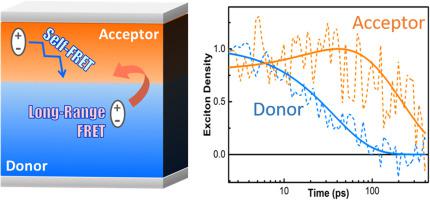Nano Energy ( IF 17.6 ) Pub Date : 2021-02-24 , DOI: 10.1016/j.nanoen.2021.105924 Song Yi Park , Sreelakshmi Chandrabose , Michael B. Price , Hwa Sook Ryu , Tack Ho Lee , Yun Seop Shin , Ziang Wu , Woojin Lee , Kai Chen , Shuixing Dai , Jingshuai Zhu , Peiyao Xue , Xiaowei Zhan , Han Young Woo , Jin Young Kim , Justin M. Hodgkiss

|
The development of organic photovoltaic (OPV) cells has long been guided by the idea that excitons – bound electron-hole pairs created by light absorption – diffuse only 5–10 nm. True for many materials, this constraint led to an inherently complex device architecture – the bulk heterojunction – that has obscured our understanding of device physics, and handicapped rational material design. Here, we investigate the photophysics of a series of planar bilayer heterojunction devices incorporating fused-ring electron acceptors with power conversion efficiencies up to 11%. Using ultrafast optical spectroscopy, we demonstrate the importance of long-range layer-to-layer energy transfer in planar structures, isolating this effect by including an insulating layer between the donor and acceptor layers to eliminate charge transfer effects. We show that the slab geometry facilitates substantially longer-range energy transfer than between isolated molecules or small domains. Along with high molecular packing densities, high absorption coefficients, and long exciton diffusion lengths, we show that these effects amount to exciton harvesting length scales that match the light absorption lengths and thereby enable efficient bilayer devices. Our quantitative analysis of bilayer structures also accounts for large domain sizes in bulk-heterojunction devices including fused-ring electron acceptors, and it quantifies the importance of strong resonant spectral overlap is for material selection and design for highly efficient OPVs.
中文翻译:

高效双层有机太阳能电池中的光物理路径:层间能量转移的重要性
长期以来,有机光伏(OPV)电池的发展一直受到以下观念的指导:激子-由光吸收形成的结合的电子-空穴对-仅扩散5-10 nm。对于许多材料而言,这种约束确实导致了设备本身固有的复杂结构-整体异质结-使得我们对设备物理的理解变得模糊,并阻碍了合理的材料设计。在这里,我们研究了一系列平面双层异质结器件的光物理特性,该器件结合了具有高达11%的功率转换效率的稠环电子受体。使用超快光谱,我们证明了平面结构中长距离层到层能量转移的重要性,通过在施主层和受主层之间包括绝缘层来消除电荷转移效应,从而隔离了这种效应。我们表明,平板的几何形状比分离的分子或小区域之间的能量转移范围大得多。伴随着高分子堆积密度,高吸收系数和长激子扩散长度,我们证明了这些效应相当于与光吸收长度匹配的激子收获长度尺度,从而使高效的双层器件成为可能。我们对双层结构的定量分析还说明了包括稠环电子受体在内的体-异质结器件的大畴尺寸,并且它量化了强共振光谱重叠对于材料选择和高效OPV设计的重要性。高的吸收系数和长的激子扩散长度,我们证明了这些效应达到了与光吸收长度相匹配的激子收获长度尺度,从而实现了高效的双层器件。我们对双层结构的定量分析还说明了包括稠环电子受体在内的体-异质结器件的大畴尺寸,并且它量化了强共振光谱重叠对于材料选择和高效OPV设计的重要性。高的吸收系数和长的激子扩散长度,我们证明了这些效应达到了与光吸收长度相匹配的激子收获长度尺度,从而实现了高效的双层器件。我们对双层结构的定量分析还说明了包括稠环电子受体在内的体-异质结器件的大畴尺寸,并且它量化了强共振光谱重叠对于材料选择和高效OPV设计的重要性。



























 京公网安备 11010802027423号
京公网安备 11010802027423号